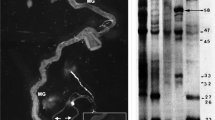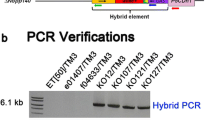Abstract
We report in this paper the characterization of Dxbp-1, the Drosophila homologue of the xpb-1 gene that encodes a “bZIP”-containing transcription factor that plays a key role in the unfolded protein response (UPR), an evolutionarily conserved signalling pathway activated by an overload of misfolded proteins in the endoplasmic reticulum (ER). Dxbp-1 is ubiquitously transcribed, and high levels are found in embryonic salivary glands and in the ovarian follicle cells committed to the synthesis of the respiratory appendages. Loss of function of Dxbp-1 induced a recessive larval lethality, thus, revealing an essential requirement for this gene. The Dxbp-1 transcript was submitted to an “unconventional” splicing that generated a processed Dxbp-1s transcript encoding a DXbp-1 protein isoform, as is the case for yeast, Caenorhabditis elegans and vertebrate hac1/xbp-1 transcripts after UPR activation. However, in the absence of exogenously induced ER stress, the Dxbp-1s transcript was also detectable not only throughout embryonic and larval development but also in adults with a high level of accumulation in the male sexual apparatus and, to a lesser extent, in the salivary glands of the third-instar larvae. Using a Dxbp-1:GFP transgene as an in vivo reporter for Dxbp-1 mRNA unconventional splicing, we confirmed that Dxbp-1 processing took place in the salivary glands of the third-instar larvae. The Dxbp-1 gene appears, thus, to play an essential role during the development of Drosophila, hypothetically by stimulating the folding capacities of the ER in cells committed to intense secretory activities.




Similar content being viewed by others
References
Bier E, Vaessin H, Shepherd S, Lee K, Mc Call K, Barbel S, Ackerman L, Carretto R, Uemura T, Grell E, Jan LY, Jan YN (1989) Searching for pattern and mutation in the Drosophila genome with a p-lacZ vector. Genes Dev 3:1273–1287
Bobinnec Y, Marcaillou C, Morin X, Debec A (2003) Dynamics of the endoplasmic reticulum during early development of Drosophila melanogaster. Cell Motil Cytoskelet 54:217–225
Calfon M, Zeng H, Urano F, Till JH, Hubbard SR, Harding HP, Clark SG, Ron D (2002) IRE-1 couples endoplasmic reticulum load to secretory capacity by processing the XBP-1 mRNA. Nature 415:92–96
Cao Y, Knöchel S, Oswald F, Donow C, Zhao H, Knöchel W (2006) XBP1 forms a regulatory loop with BMP-4 and suppresses mesodermal and neural differentiation in Xenopus embryos. Mech Dev 123:84–96
Clauss IM, Gravallese EM, Darling JM, Shapiro F, Glimcher MJ, Glimcher LH (1993) In situ hybridization studies suggest a role for the basic region-leucine zipper protein Hxbp-1 in exocrine gland and skeletal development during mouse embryogenesis. Dev Dyn 197:146–156
Cox JS, Walter P (1996) A novel mechanism for regulating activity of a transcription factor that controls the unfolded protein response. Cell 87:391–404
Gass JN, Gifford NM, Brewer JW (2002) Activation of an unfolded protein response during differentiation of antibody-secreting B cells. J Biol Chem 277:49047–49054
Haze K, Yoshida H, Yanagi H, Yura T, Mori K (1999) Mammalian transcription factor ATF6 is synthesized as a transmembrane protein and activated by proteolysis in response to endoplasmic reticulum stress. Mol Biol Cell 10:3787–3799
Iwakoshi NN, Lee AH, Glimcher LH (2003a) The X-box binding protein-1 transcription factor is required for plasma cell differentiation and the unfolded protein response. Immunol Rev 194: 29–38
Iwakoshi NN, Lee AH, Vallabhajosyula P, Otipoby KL, Rajewsky K, Glimcher LH (2003b) Plasma cell differentiation and the unfolded protein response intersect at the transcription factor XBP-1. Nat Immunol 4:321–329
Iwawaki T, Akai R, Kohno K, Miura M (2004) A transgenic mouse model for monitoring endoplasmic reticulum stress. Nat Med 10:98–102
Januschke J, Gervais L, Dass S, Kaltschmidt JA, Lopez-Schier H, St. Johnston D, Brand AH, Roth S, Guichet A (2002) Polar transport in the Drosophila oocyte requires dynein and kinesin I cooperation. Curr Biol 12:1971–1981
Lee K, Tirasophon W, Shen X, Michalak M, Prywes R, Okada T, Yoshida H, Mori K, Kaufman RJ (2002) IRE-1-mediated unconventional mRNA splicing and S2P-mediated ATF6 cleavage merge to regulate XBP1 in signaling the unfolded protein response. Genes Dev 16:452–466
Lee AH, Iwakoshi NN, Glimcher LH (2003) XBP-1 regulates a subset of endoplasmic reticulum resident chaperone genes in the unfolded protein response. Mol Cell Biol 23:7448–7459
Lee AH, Chu GC, Iwakoshi NN, Glimcher LH (2005) XBP-1 is required for biogenesis of cellular secretory machinery of exocrine glands. EMBO J 24:4368–4380
Liou HC, Boothby MR, Finn PW, Davidon R, Nabavi N, Zeleznik-Le NJ, Ting JP, Glimcher LH (1990) A new member of the leucine zipper class of proteins that binds to the HLA DR alpha promoter. Science 247:1581–1584
Ma Y, Hendershot LM (2001) The unfolding tale of the unfolded protein response. Cell 107:827–830
Masaki T, Yoshida M, Noguchi S (1999) Targeted disruption of CRE-binding factor TREB5 gene leads to cellular necrosis in cardiac myocytes at the embryonic stage. Biochem Biophys Res Commun 261:350–356
Mori K, Ogawa N, Kawahara T, Yanagi H, Yura T (2000) mRNA splicing-mediated C-terminal replacement of transcription factor Hac1p is required for efficient activation of the unfolded protein response. Proc Natl Acad Sci U S A 97:4660–4665
Nakagawa T, Zhu H, Morishima N, Li E, Xu J, Yankner BA, Yuan J (2000) Caspase-12 mediates endoplasmic-reticulum-specific apoptosis and cytotoxicity by amyloid-beta. Nature 403:98–103
Rao RV, Hermel E, Castro-Obregon S, del Rio G, Ellerby LM, Ellerby HM, Bredesen DE (2001) Coupling endoplasmic reticulum stress to the cell death program. Mechanism of caspase activation. J Biol Chem 276:33869–33874
Reimold AM, Etkin A, Clauss I, Perkins A, Friend DS, Zhang J, Horton HF, Scott A, Orkin SH, Byrne MC, Grusby MJ, Glimcher LH (2000) An essential role in liver development for transcription factor XBP-1. Genes Dev 14:152–157
Reimold AM, Iwakoshi NN, Manis J, Vallabhajosyula P, Szomolanyi-Tsuda E, Gravallese EM, Friend D, Grusby MJ, Alt F, Glimsher LH (2001) Plasma cell differentiation requires the transcription factor XBP-1. Nature 412:300–307
Rubin GM, Spradling AC (1982) Genetic transformation of Drosophila with transposable element vectors. Science 218:348–353
Schroder M, Kaufman RJ (2005) The mammalian unfolded protein response. Annu Rev Biochem 74:739–789
Shen X, Ellis RE, Lee K, Liu CY, Yang K, Solomon A, Yoshida H, Morimoto R, Kurnit DM, Mori K, Kaufman RJ (2001) Complementary signaling pathways regulate the unfolded protein response and are required for C. elegans development. Cell 107:893–903
Shen X, Ellis RE, Sakaki K, Kaufman RJ (2005) Genetic interactions due to constitutive and inducible gene regulation mediated by the unfolded protein response in C. elegans. PLoS Genet 1:355–368
Sidrauski C, Walter P (1997) The transmembrane kinase Ire-1p is a site-specific endonuclease that initiates mRNA splicing in the unfolded protein response. Cell 90:1031–1039
Taillebourg E, Moreau-Fauvarque C, Delaval K, Dura JM (2005) In vivo evidence for a regulatory role of the kinase activity of the linotte/derailed receptor tyrosine kinase, a Drosophila Ryk ortholog. Dev Genes Evol 215:158–163
Tirosh B, Iwakoshi NN, Glimcher LH, Ploegh HL (2006) Rapid turnover of unspliced xbp-1 as a factor that modulates the unfolded protein response. J Biol Chem 281:5852–5860
Torok T, Tick G, Alvarado M, Kiss I (1993) P-lacW insertional mutagenesis on the second chromosome of Drosophila melanogaster: isolation of lethals with different overgrowth phenotypes. Genetics 135:71–80
Urano F, Bertolotti A, Ron D (2000a) IRE-1 and efferent signaling from the endoplasmic reticulum. J Cell Sci 113:3697–3702
Urano F, Wang X, Bertolotti A, Zhang Y, Chung P, Harding HP, Ron D (2000b) Coupling of stress in the ER to activation of JNK protein kinases by transmembrane protein kinase IRE-1. Science 287:664–666
Wu J, Kaufman RJ (2006) From acute ER stress to physiological roles of the unfolded protein response. Cell Death Differ 13:374–384
Yamamoto K, Yoshida H, Kokame K, Kaufman RJ, Mori K (2004) Differential contributions of ATF6 and XBP1 to the activation of endoplasmic reticulum stress-responsive cis-acting elements ERSE, UPRE and ERSE-II. J Biochem (Tokyo) 136:343–350
Ye J, Rawson RB, Komuro R, Chen X, Dave UP, Prywes R, Brown MS, Goldstein JL (2000) ER stress induces cleavage of membrane-bound ATF 6 by the same proteases that process SREBPs. Mol Cell 6:1355–1364
Yoshida H, Haze K, Yanagi H, Yura T, Mori K (1998) Identification of the cis-acting endoplasmic reticulum stress response element responsible for transcriptional induction of mammalian glucose-regulated proteins; involvement of basic-leucine zipper transcription factors. J Biol Chem 273: 33741–33749
Yoshida H, Matsui T, Yamamoto A, Okada T, Mori K (2001) XBP1 mRNA is induced by ATF6 and spliced by IRE-1 in response to ER stress to produce a highly active transcription factor. Cell 107:881–891
Yoshida H, Oku M, Suzuki M, Mori K (2006) pXBP1(U) encoded in XBP1 pre-mRNA negatively regulates unfolded protein response activator pXBP1(S) in mammalian ER stress response. J Cell Biol 172:565–575
Yoshimura T, Fujisawa J, Yoshida M (1990) Multiple cDNA clones encoding nuclear proteins that bind to the tax-dependent enhancer of HTLV-1: all contain a leucine zipper structure and basic amino acid domain. EMBO J 9:2537–2542
Zhao H, Cao Y, Grunz H (2003) Xenopus X-box binding protein 1, a leucine zipper transcription factor, is involved in the BMP signaling pathway. Dev Biol 257:278–291
Acknowledgements
We thank Jean Maurice Dura for kindly providing the lio-Gal4 driver line and all the members of the laboratory for helpful discussions throughout the course of this work. We also thank the two anonymous reviewers for their insightful comments and suggestions. S.S. was supported by a predoctoral fellowship from the Fondation pour la Recherche Médicale.
Author information
Authors and Affiliations
Corresponding author
Additional information
Communicated by C. Desplan
Electronic supplementary material
Below is the image is a link to a high resolution version
Fig. S1
Deduced sequences of DXbp-1u and DXbp-1s proteins. Amino acids of the amino-terminal region shared by the two proteins are depicted in black. Within this region, the basic domain is underlined and the leucine residues constituting the “leucine zipper” are indicated in green. Residues of the carboxy-terminal specific domains of the DXbp-1u and DXbp-1s proteins are represented in blue and red, respectively (GIF 12 841 kb)
Fig. S2
Hypothetical structures of Ire-1 cleavage sites. Secondary structure of Ire-1 cleavage sites (red arrowheads) and adjacent sequences of D. melanogaster, C. elegans, Brachydanio rerio and Mus musculus xbp-1 transcripts, as deduced from visual and in silico examinations of xbp-1 sequences (GIF 6 767 kb)
Fig. S3
ER stress induces putative Ire-1-dependent processing of Dxbp-1 RNA. RT-PCR analysis of Dxbp-1s accumulation after the activation of the UPR pathway in adults. PCR amplifications were performed using genomic DNA (Gen) or reverse transcribed RNA extracted from non-treated adults (0) or from flies fed with 20, 40 or 60 μg/ml tunicamycine (GIF 32 523 kb)
Rights and permissions
About this article
Cite this article
Souid, S., Lepesant, JA. & Yanicostas, C. The xbp-1 gene is essential for development in Drosophila . Dev Genes Evol 217, 159–167 (2007). https://doi.org/10.1007/s00427-006-0124-1
Received:
Accepted:
Published:
Issue Date:
DOI: https://doi.org/10.1007/s00427-006-0124-1




